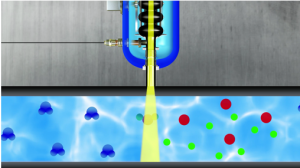Much interest has been generated in water treatment by electron beam irradiation because of the effectiveness of ionizing radiation in the decomposition of microorganisms and undesirable organic contaminants. Applying electrons to treat water is a viable solution because when water is subjected to high-energy electrons, it produces highly reactive species such as hydrated electrons, hydroxyl radicals and hydrogen atoms that destroy organic materials. Electron beam treatment is the only form of energy that produces highly oxidizing and reducing species at the same time.
Fermilab received development money from DOE’s Accelerator Stewardship program to further the conceptual design for a medium- to large-scale high-energy, high-power electron beam accelerator to meet the bio-solids (sludge) treatment requirements of a large municipality. The project was a collaborative design effort that included Colorado State University, Northern Illinois University, Euclid TechLabs, and the Metropolitan Wastewater Reclamation District of Greater Chicago (MWRD). MWRD operates the largest wastewater treatment plant in the world in Stickney, Illinois, and is providing the design team with information concerning end-user requirements, as well as samples for testing. Based on the encouraging results of the first study at 1 MW, the IARC team secured additional funding to extend the conceptual design to a higher power 10 MW electron accelerator. Fermilab continues to work with MWRD in testing samples to measure the removal of toxins and pathogens that are of growing concern.
E-beam treatment of water has already demonstrated the capability to:
- Increase dewaterability of sludges
- Remove toxic chemicals like pharmaceuticals, fuel additives (MTBE), polychlorobiphenyls (PCBs), halogenated solvents (TCE) and pesticides from agricultural runoff
- Reduce pathogens
Multiple efforts have shown the usefulness of e-beam technology for full scale wastewater treatment. In the 1990s, the Miami Dade County municipal waste water treatment system demonstrated the capability of e-beams to effectively kill bacteria in sludge (CN Kurucz et al., Radiat. Phys. Chem. 1995). One issue with this study was that it used an inefficient e-beam accelerator and therefore the operating cost was impractical for large scale application.
The technology offers many advantages and typically without any secondary waste generation. E-beam treatment has broad range impacts in that it breaks down most anything in water (except metals or ions) so that not only can it treat contaminants of concern today, but it will likely also be able to treat unknown emerging contaminants. The main drawbacks from e-beam technology with regards to wastewater treatment are that conventional e-beam accelerators have low volume flow capacities, are energy intensive and occupy a large space, making it difficult to integrate into existing water treatment facilities. Fermilab’s design addresses these concerns and opens up the possibility of treating large volume flow rates via e-beam.
Read more:
Researchers at Fermilab use electron beams to eradicate forever chemicals in water


